
Transpac Fleet Roars In
A couple of days after the biggest and fastest yachts started to trickle into Honolulu in the 50th running of the Transpac race, the flood gates have fully opened with the bulk of the fleet beginning to arrive on Sunday.
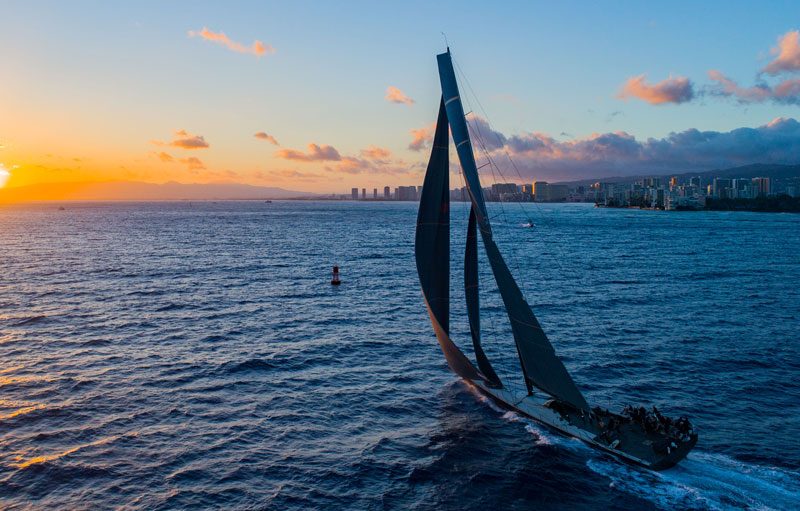
As boats are now arriving on an almost hourly basis, the results picture is beginning to come into focus. As it does, it becomes abundantly clear that this was a good year to be in the second wave of starts and especially to be sailing a J/125. The all-carbon J/Boat rocket ship, with just 16 hulls produced in total, has dominated the overall results. Just as the Pac52s did in 2017, J/125s appear to have locked up first and second place overall, with all four boats entered correcting out into the top six. Bay Area favorites Velvet Hammer, led by Zachery Anderson and Chris Kramer, sailed a brilliant race to claim second place in division and second place overall, only bested by Shawn Dougherty and Jason Andrews’ Seattle-based J/125 Hamachi.
Behind the top two J/Boats, Bob Pethick’s Rogers 46 Bretwalda 3 appears to have claimed the final podium spot in the overall rankings, putting one of the relatively rare Simon Rogers designs on the podium of the Transpac for the second year running. Santa Cruz 50s and 52s came home in 7th, 8th and 9th overall, meaning that the Friday starters will have claimed eight of the top 10 spots in the overall rankings. Only the Eddy family’s Cal 40 Callisto and Tom Holthus’ Pac 52 BadPak break the stranglehold that the Friday wave has over the top 10 spots overall. These results are provisional and subject to change as Callisto is still on the course.
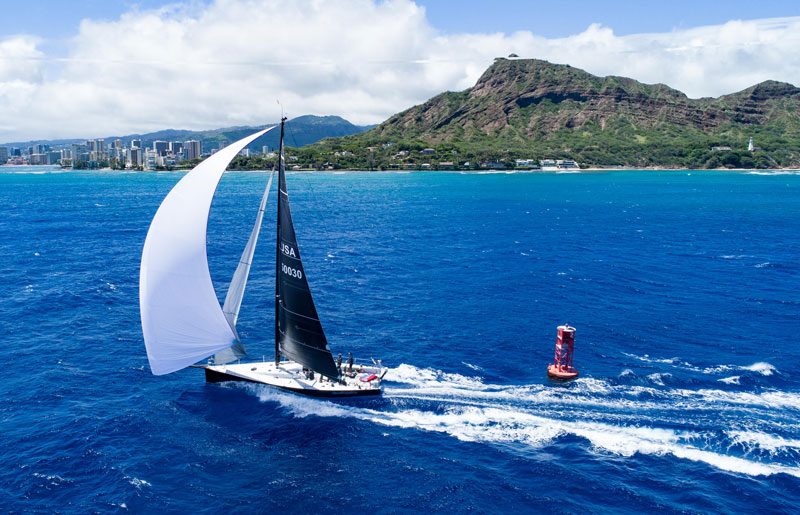
After the light air of the last wave of starts, carnage and rudder failures, and the loss of OEX, the rest of this year’s massive fleet has enjoyed absolutely glamour Transpac conditions: strong, steady easterly trade winds and mostly sunny skies, save for some tropical squalls. “It was windy this year, especially a little bit farther down the race course,” concluded Velvet Hammer owner and skipper Zachery Anderson, a multi-time Hawaii race veteran who has completed his first crossing on his new-to-him J/125. “The J/125 went shockingly fast, hitting huge numbers for boat speed and just sitting there at high speed. These are really special boats.”
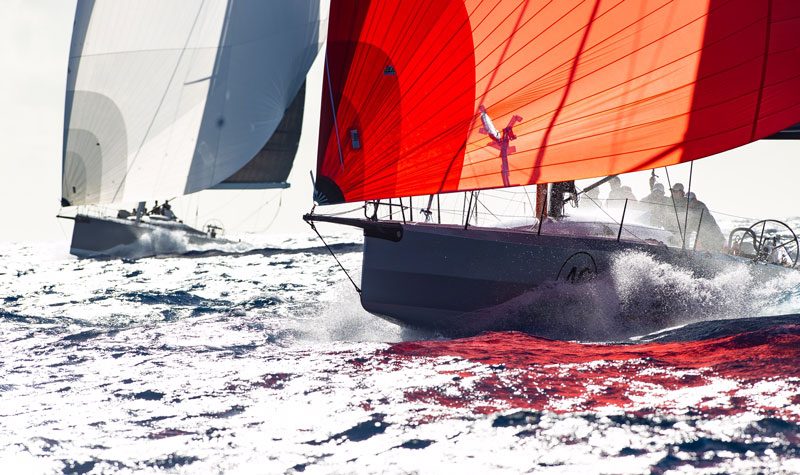
Aside from the 40-something-footers that dominated the top of the overall standings, it was also a great year for the SC50s and 52s, with three coming home in the top 10 overall. Winning this ultra-close and competitive division was the Bay Area’s Michael Moradzadeh and his all-star crew on the SC50 Oaxaca. Sailing with a trio of highly acclaimed female sailors (Dee Caffari, Liz Baylis and Molly Noble), Oaxaca corrected out less than 12 minutes over perennial contender Horizon, now owned by John Shulze of Huntington Beach.
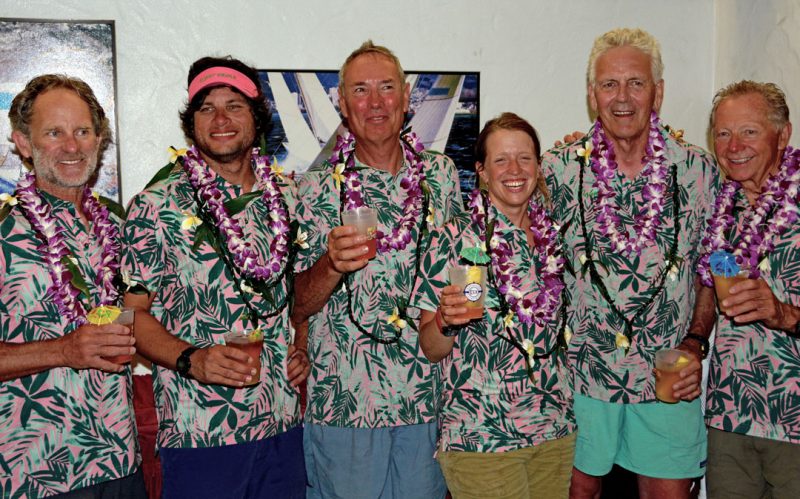
A large pack of racer/ cruisers, a few Division 1 stragglers, and a fleet of Cal 40s are currently inbound to the islands and lining up a Monday arrival. More than half of the fleet is now moored in Hawaii. By tonight, only a handful should be left on the race course. See https://2019.transpacyc.com.
The Rare Gem that Is the Dutch Shoe Marathon
There aren’t many dinghy regattas that bring in hundreds of boats, have a mix of juniors and seniors, and sail the entire length of a bay over several hours. But that, in a nutshell, is the Dutch Shoe Marathon. Friday saw the 47th running of what, by the numbers, is one of SoCal’s biggest regattas. Starting at Shelter Island, finishing in Coronado, and mixing it up with whatever commercial and Navy traffic might be transiting San Diego Bay, the Dutch Shoe has four divisions: A, B, and C Fleets, as well as the seniors.
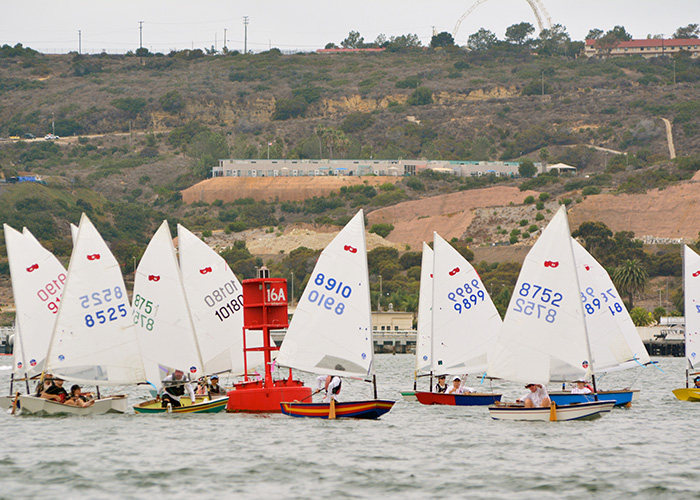
Paige Tillson, an 11-year-old C Fleeter from Mission Bay Yacht Club, came in first in the nearly 200-boat fleet, and held a solid lead for the entire race, according to a press release from San Diego Yacht Club. Given Southern California’s consistent and (sometimes infuriatingly) mellow sea breeze, the Dutch Shoe typically takes about three hours to sail. When asked how it felt to win the iconic regatta, Tillson said, “It’s exciting, but I’m also really tired,” SDYC reported. Tillson’s older brother Shane, a 13-year-old A Fleeter, was sailing in his fourth Dutch Shoe. “I just love this whole race. It’s so different from everything else,” SDYC said. “The hardest part is where the Navy ship is because there is a big wind shadow there. You have to be really patient because you can either pass a lot of boats or they can pass you,” he finished.
The elder Tillson alluded to the real X-factors of the Dutch Shoe: the hulking, draft-restricted warships that have made such a regular appearance in the race over the years (which is always held on a Friday) it almost seems as if they’re running in the regatta. (Those ships, as Shane Tillson noted, are also a wind-shadow factor when docked.) The Dutch Shoe becomes an extraordinary herding effort for coaches and support boats to get hundreds of Sabots down the bay.
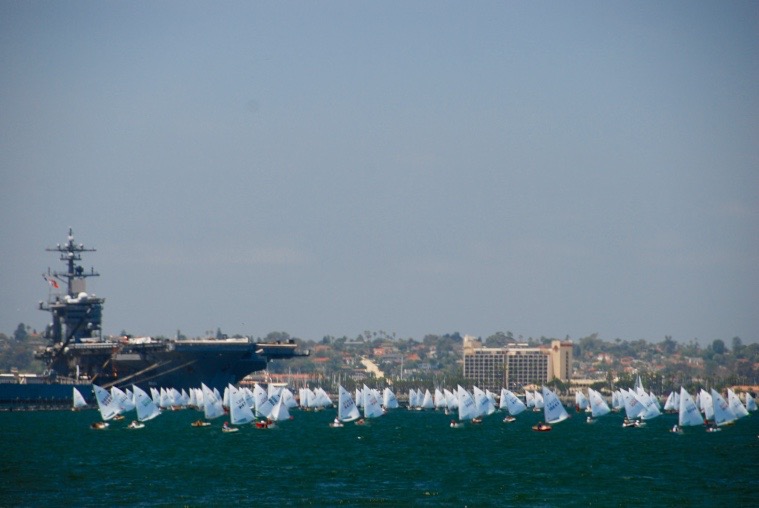
We cannot talk about the Dutch Shoe without discussing the Naples Sabot, the dinghy of choice and tradition in Southern California. First built in Naples, Long Beach, the Naples Sabot, which uses a leeboard, is a variation of the Charles MacGregor’s Sabot, which uses a daggerboard — this according to Wikipedia, that most trusted of sources for real journalists. “The leeboard gives the boat additional versatility, making it easy to use as a rowboat and thus permitting it to be used as a tender or for fishing.” Another variation of MacGregor’s Sabot was the El Toro, the Bay Area’s own ultra-regional dinghy.
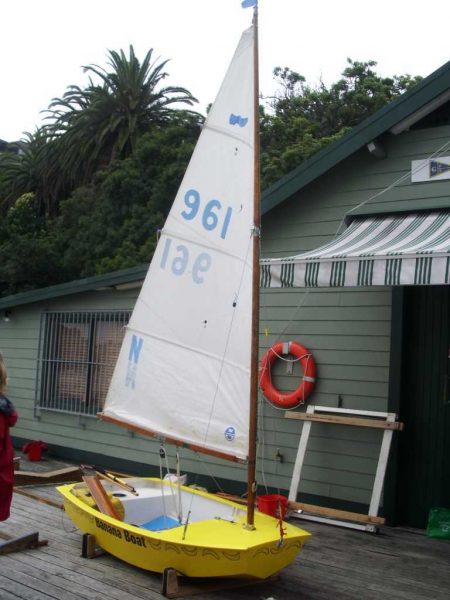
While some SoCal clubs have a small fleet of the far more ubiquitous Optimist for their juniors to practice for international races, all serious junior racing is done in the Sabot, which has produced fine sailors over the years. (Some past winners of the Dutch Show represent a who’s who of San Diego sailing talent, including: Danny North, Andrew Campbell, Bill Hardesty, Lauren Maxam, Parker Shinn, Ty Reed, Katie Love, Adam Roberts, Tyler Sinks, Frank Tybor, Randy Lake, Piet van Os and many more.)
Compared to Optis, Sabots are far more idiosyncratic — both in performance and appearance — than the generic Opti, and have a variety of concepts, colors and configurations.
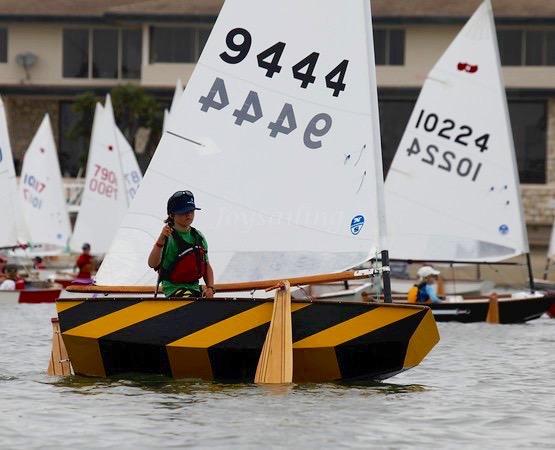
There are other impressive dinghy regattas, like the El Toro’s “Bullship.” There was a Bullship held at Kaneohe Yacht Club in September 2018 for both juniors and seniors; the Bay Area Bullship is a seniors-only regatta sailing from Sausalito to San Francisco — while that’s a serious piece of water to cross, the Bullship ‘only’ draws a few dozen boats. There are few regattas that can compete with the Dutch Shoe for its size.
Or are there?
If you have a favorite dinghy regatta, please chime in. If you know why a boat that was built in California but has an Italian city’s name and has a Dutch shoe on its sail, please let us know (and help us fill the vast holes in our reporting). If you have a strong preference for, or want to share your experiences of a particular junior boat, please chime in by commenting below, or emailing us here. And please be sure to include your Boat Name, Make and Port of Call, or just tell us where you’re from.
Brickyard Cove Marina
Inaugural Great J/24 Jacuzzi Rio Run Cruise
When the J/24 was introduced in 1976, the brochure featured shots of the four-berth interior as part of its appeal as a family racer/cruiser. The local J/24 fleet submitted the following about their Rio Vista cruise, demonstrating the always-competitive nature of racer/cruisers.
A rally to Rio Vista somehow involved sailing with double spinnakers
It was a Dark ’n’ Stormys kinda night when the newest boat owner in the Bay Area J/24 fleet shared a bit about his family history and mentioned: “My family has a house on the Sacramento Delta. It has an excellent Jacuzzi.” Nonchalant Foredeck replied: “I bet we could sail there, if the tides were right.” Rational Foredeck added, “This will answer the question that no one was asking: What happens when you mix a handful of J/24 racers, a summer cruise-out and tequila?” Madman’s ice clinks against his teeth. “Brilliant! 46 miles of downwind sailing. Make it so!”
Casting off at 9 a.m. on a misty Bay Area 4th of July, Madman hoists his 4-ft banner in support of the Dutch Women’s Soccer team (and said banner promptly wraps around the head of the mast, later requiring The Newbie to be hoisted to retrieve it before the boat and crew can dock at the end of the day and partake in fruity rum drinks). Not to be vexed, the vexillologist executes multiple flag-unfurling maneuvers, hoists additional flags to buoy the spirits of the entangled one, and finally decides napping is the better part of valor and goes belowdecks for nap #1 of the day. Nonchalant Foredeck, suddenly aft of the mast, gulps and holds the tiller.
Later, somewhere in the vicinity of Sherman Island
Enjoying the warming breeze and de-layering crew, Madman says, “I’ve been thinking about a thong.” Butter & Thongs is the tentative name for our host’s new-to-him J/24, based on a pinchy talking crab video that has become a constant meme about pinching to windward, so the assumption was he was thinking about logo design.
“No, not that,” he clarified. “I mean that Max Ebb article where Lee Helm talks about a ‘thong line’ going down the middle of the spinnaker to make it more stable. I’ve been wondering what it would be like to hoist two symmetrical kites. It seems like it would be a similar shape but on a larger scale.”
A short time later, Rational Foredeck replies: “I’d like to go on record that this is a Bad Idea.”
Nonchalant Foredeck adds, “It’s your boat. I’m just holding this sheet and this guy, which are connected to different sails.”
Madman says, “Oh, I think I have a Jazz Cup flag I can hoist too.”
One would think dropping the main would be key to instantly filling the leeward of the two spinnakers while dead downwind, and one would be right. The problem is that the Dutch soccer flag is so stuck in the mechanisms that the main will only go down six feet.
Turns out, that was enough.
While a proud, full, double-breasted spinnaker can be seen from in front, the slouchy main is seen from the back; nonetheless, it works.
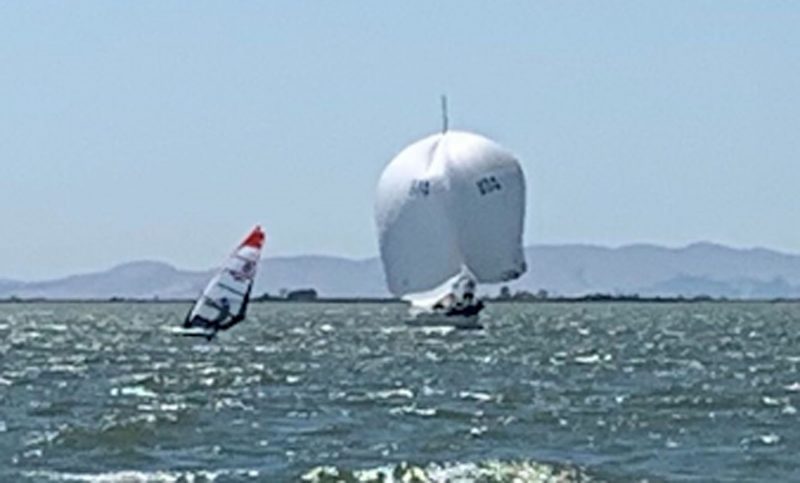
Two spinnaker poles are deployed, one on each side, but the crack team soon realizes the starboard pole can be dismissed. The port kite clew is secured to the foredeck D-ring with a sail tie; the starboard kite’s tack is flown off the pulpit with another sail tie. A single guy on the port kite and sheet on the starboard kite complete the rig.
New J/24 Owner and Another J/24 Owner look back at the rapidly approaching double-kited, double-foredecked Madman, and know the race is on, incorrectly predicting an interesting douse for the amusement of Crew.
Indeed, the boat seems rather stable, but she’s already at her hull speed. As the river bend approaches, Madman decides a beer nap is better than trying a hotter angle with two kites. Both Foredecks think a jibe is another Bad Idea and, of course, want to confirm their hunch.
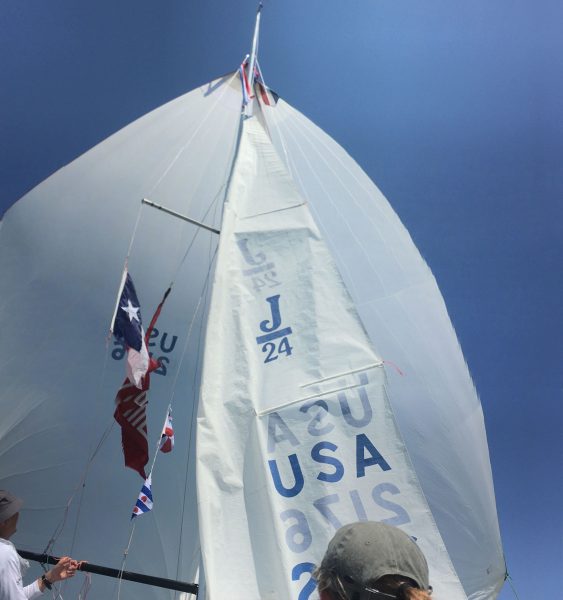
To celebrate arriving in the warm waters of Rio Vista just over eight hours after casting off, a Texas flag is now hoisted. Rio Vistans respond with a cacophony of Roman candles purchased from the corner fireworks stands.
Nonchalant Foredeck, while reclining next to a Jacuzzi jet with a glass of rosé, says, “This was a really bad idea. Too easy. We’re going to think we can do this again next year.”
But then there was the upwind return to Richmond still to be faced.

